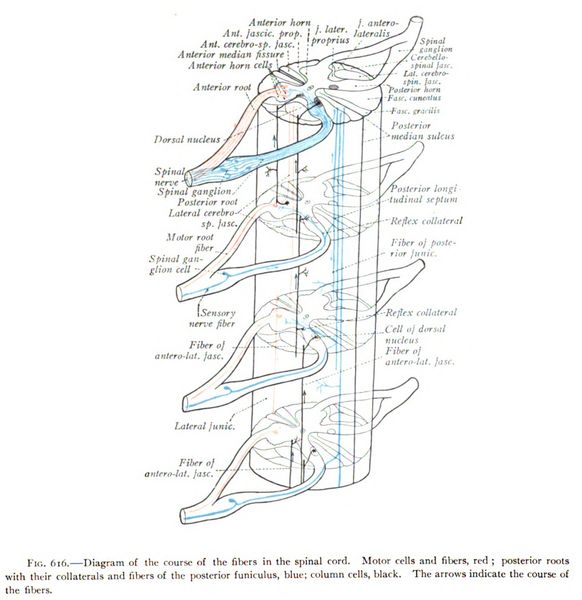Pain, posture, and itching
Researchers have recently identified specific cells in the spinal cord that help reduce pain and itching. Intriguingly, these same cells may be involved in control of posture and gait (walking patterns).
The spinal cord is a complex thing! Here's a diagram from an old text book:

So where are these cells that may be so useful in reducing pain? Well they're a specific type of spinal "interneuron". As you might expect, a spinal interneuron is a neuron (nerve cell) that sits between two or more other nerve cells in the spinal cord. We've known about interneurons for decades. They form part of some reflexes, such as the familiar "knee jerk" reflex that your osteopath or doctor may test by tapping your knee. Intriguingly the interneurons in that particular reflex reduce the strength of the knee-jerk: they inhibit the action of the muscles. The signal still gets through, but the interneurons reduce it somewhat.

This is gives us a small insight into the complexity of the central nervous system: various neurons exciting and inhibiting each other to keep the whole system in a balance allowing us to function optimally.
It has been discovered that certain interneurons (glycinergic dorsal horn neurons, to give them their full name) inhibit certain signals, preventing them from reaching the brain. In this way they help reduce two particular sensations: pain, and itching.
This is a small piece of evidence that supports the "gate control" theory of pain. 50 years ago the scientists who proposed the gate control theory stated that interneurons in the spine must suppress pain in some way — it's taken us this long to catch up to the theory.
How does this help us? As with a lot of research, it's a little early to say exactly. No doubt pharmacologists and gene therapists will look at these cells to see if we can influence their behaviour, helping to control severe or long-term pain and itching.
In the meantime, this supports the practice of hands-on therapy, because these glycinergic dorsal horn neurons receive information from "sensory neurons": the nerve cells that are active when we are touched. This helps us start to explain why simply touching another person can help to reduce their pain. It's a small step, but a vital and interesting one!
You can read more about the research on the Guardian website.